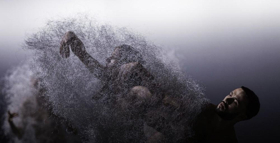Review: AVIGNON THEATRE FESTIVAL Presents KREATUR by SASHA WALTZ

The figures that appear in Sasha Waltz's Kreatur, now in performance at Opera Confluence at the Avignon Theatre Festival, defy belief. The incomparable costume design by Iris van Herpen transforms the human body with spikes, light as air cocoons, and patterns that appear and disappear from view depending on the angle. Soundwalk Collective's soundscape fascinates as it distorts electronic rhythm, industrial machinery, the sounds of nature, and, in one fabulous instance, The Nutcracker's "Arabian Dance." With so many elements of the performance attempting to drag the spectator to an alternate dimension, it is a shame that the world on stage remains one of concert dance convention.
The stage is mostly bare, save a thin white staircase that runs parallel to the wings stage left. Upstage a large gray cyc is lit usually with either a horizon line of stark white, or a thick horizontal gradient of white that expands from the center like a Leger painting. The performance begins in a deep twilight as dancers disjointedly amble around resembling large dandelions in their own personal cocoons. The dancers experiment as their arms reach forward into the air of the theatre. Slowly other dancers, simply dressed in flesh-toned shorts, begin to enter the space. One of these dancers brings with them a large sheath of a glossy material. This material distorts the form through reflection and refraction in ways that no amount of visual study is able to untangle. Though, no matter, it's off to the next image, and then the next after that.
The remainder of the piece wavers in and out of concepts. The entire cast attempts to assemble on the thin white staircase. It is a fascinating prospect that could have resulted in discoveries and reflections on crowds and claustrophobia, but it is swiftly discarded as the cast dismounts. A large beam of wood is held upright as a man balances high above the cast on his stomach. He soars in a rare moment of stillness. Yet here too, we aren't given much time to ponder. This lack of focus leaves the events on stage feeling flat. This flatness, coupled with Waltz's dispersed placement, makes the movement busy rather than energetic. While there are some powerful moments where a single dancer is allowed to take the entire stage, most of the performance consists of disconnected choreographic groupings. Any one of these groupings might yield results, but while under visual competition they simply cancel each other out.
Taken individually, Kreatur offers astonishing moments. A dancer begins to weep heavily. She takes refuge on the top of the stairs. Another dancer reprimands her "Stop crying!" This command soon deteriorates to "Stop breathing!" We are left imagining the emotional and physical exhaustion of the dancer as she attempts to hold her breath. It is a stark and human exploration of the body and our capacity to control it and why. A dancer resembling a sea urchin in a black spiked costume enters the space. This dancer confronts first a soloist and then proceeds to harass the entire group. The dancer sassily plays with the spikes and we can feel the tingling brush as it gently propels itself against its victims. This dancer is brought into an embrace by the corps and the spiked head is removed to revel the dancer underneath. The now nearly de-spiked dancer unsheathes the rest of her armor in one swift decisive motion. It is a startling and moving event. Later, near the end of the performance, the thin stairwell is dislodged and brought center stage. It is then rocked back and forth by two dancers while a third pensively climbs. It is an intimate moment of sharing and an inventive use of space and iconography. Such images as these abound, but they are trapped in the barbed wire of Waltz's dance vocabulary. Waltz's group movements, which engage with no props or transfiguring costumes, have no option but to seem bland and conventional by comparison.
The space Waltz creates is not mundane. Indeed a sense of the quotidian might have notably added to the examination of human power structures. Instead the dancers are lost in an industrial limbo. Emotivity from the dancers is uneven both in quality and saturation. In groupings some express fully in the face, others remain stoic. This unevenness could be designated as dreamlike but the industrial nature of the set consistently brings the imagination to the material. In such a tangible space clearer rules are of assistance. The moments when lighting designer Urs Schönebaum is allowed to assert his aspect of design, as was the case in nearly all the scenes mentioned above, curiosity spikes. Iconoclastic sparks of creativity dot the performance with new manners of engaging with sense and body. It is disappointing that experiences aren't defiantly forced into the center stage and her plastic dance relegated to background and canvas.
Photo Credit: Sebastian BoleschReader Reviews
Videos

